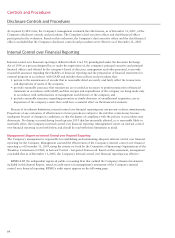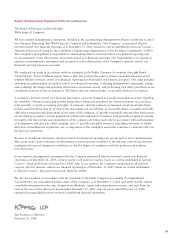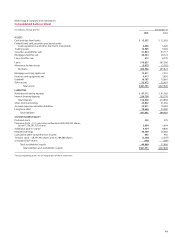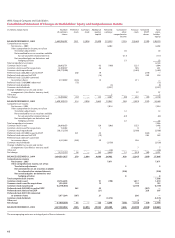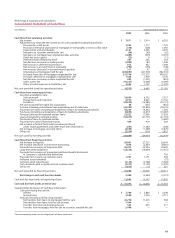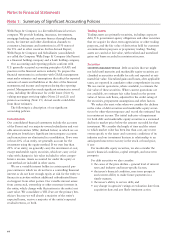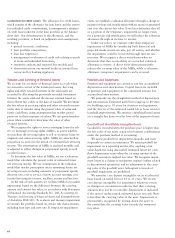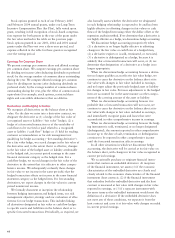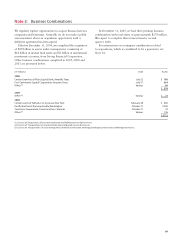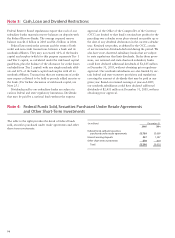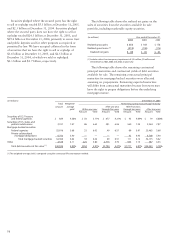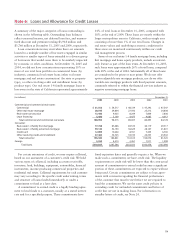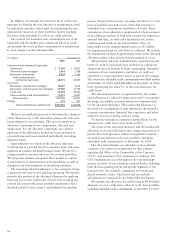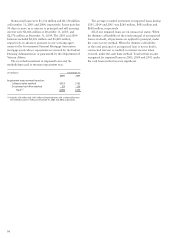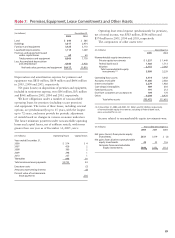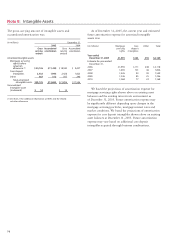Wells Fargo 2005 Annual Report Download - page 70
Download and view the complete annual report
Please find page 70 of the 2005 Wells Fargo annual report below. You can navigate through the pages in the report by either clicking on the pages listed below, or by using the keyword search tool below to find specific information within the annual report.
68
Stock options granted in each of our February 2005
and February 2004 annual grants, under our Long-Term
Incentive Compensation Plan (the Plan), fully vested upon
grant, resulting in full recognition of stock-based compensa-
tion expense for both grants in the year of the grant under
the fair value method in the table on the previous page.
Stock options granted in our 2003, 2002 and 2001 annual
grants under the Plan vest over a three-year period, and
expense reflected in the table for these grants is recognized
over the vesting period.
Earnings Per Common Share
We present earnings per common share and diluted earnings
per common share. We compute earnings per common share
by dividing net income (after deducting dividends on preferred
stock) by the average number of common shares outstanding
during the year. We compute diluted earnings per common
share by dividing net income (after deducting dividends on
preferred stock) by the average number of common shares
outstanding during the year, plus the effect of common stock
equivalents (for example, stock options, restricted share
rights and convertible debentures) that are dilutive.
Derivatives and Hedging Activities
We recognize all derivatives on the balance sheet at fair
value. On the date we enter into a derivative contract, we
designate the derivative as (1) a hedge of the fair value of
a recognized asset or liability (“fair value” hedge), (2) a
hedge of a forecasted transaction or of the variability of
cash flows to be received or paid related to a recognized
asset or liability (“cash flow” hedge) or (3) held for trading,
customer accommodation or for risk management not
qualifying for hedge accounting (“free-standing derivative”).
For a fair value hedge, we record changes in the fair value of
the derivative and, to the extent that it is effective, changes
in the fair value of the hedged asset or liability attributable
to the hedged risk, in current period earnings in the same
financial statement category as the hedged item. For a
cash flow hedge, we record changes in the fair value of the
derivative to the extent that it is effective in other compre-
hensive income. We subsequently reclassify these changes
in fair value to net income in the same period(s) that the
hedged transaction affects net income in the same financial
statement category as the hedged item. For free-standing
derivatives, we report changes in the fair values in current
period noninterest income.
We formally document at inception the relationship
between hedging instruments and hedged items, our risk
management objective, strategy and our evaluation of effec-
tiveness for our hedge transactions. This includes linking
all derivatives designated as fair value or cash flow hedges
to specific assets and liabilities on the balance sheet or to
specific forecasted transactions. Periodically, as required, we
also formally assess whether the derivative we designated
in each hedging relationship is expected to be and has been
highly effective in offsetting changes in fair values or cash
flows of the hedged item using either the dollar offset or the
regression analysis method. If we determine that a derivative is
not highly effective as a hedge, we discontinue hedge accounting.
We discontinue hedge accounting prospectively when
(1) a derivative is no longer highly effective in offsetting
changes in the fair value or cash flows of a hedged item,
(2) a derivative expires or is sold, terminated, or exercised,
(3) a derivative is dedesignated as a hedge, because it is
unlikely that a forecasted transaction will occur, or (4) we
determine that designation of a derivative as a hedge is no
longer appropriate.
When we discontinue hedge accounting because a deriva-
tive no longer qualifies as an effective fair value hedge, we
continue to carry the derivative on the balance sheet at its
fair value with changes in fair value included in earnings,
and no longer adjust the previously hedged asset or liability
for changes in fair value. Previous adjustments to the hedged
item are accounted for in the same manner as other compo-
nents of the carrying amount of the asset or liability.
When we discontinue hedge accounting because it is
probable that a forecasted transaction will not occur, we
continue to carry the derivative on the balance sheet at its
fair value with changes in fair value included in earnings,
and immediately recognize gains and losses that were
accumulated in other comprehensive income in earnings.
When we discontinue hedge accounting because the hedg-
ing instrument is sold, terminated, or no longer designated
(dedesignated), the amount reported in other comprehensive
income up to the date of sale, termination or dedesignation
continues to be reported in other comprehensive income
until the forecasted transaction affects earnings.
In all other situations in which we discontinue hedge
accounting, the derivative will be carried at its fair value on
the balance sheet, with changes in its fair value recognized in
current period earnings.
We occasionally purchase or originate financial instru-
ments that contain an embedded derivative. At inception
of the financial instrument, we assess (1) if the economic
characteristics of the embedded derivative are clearly and
closely related to the economic characteristics of the financial
instrument (host contract), (2) if the financial instrument
that embodies both the embedded derivative and the host
contract is measured at fair value with changes in fair value
reported in earnings, or (3) if a separate instrument with
the same terms as the embedded instrument would meet the
definition of a derivative. If the embedded derivative does
not meet any of these conditions, we separate it from the
host contract and carry it at fair value with changes recorded
in current period earnings.


